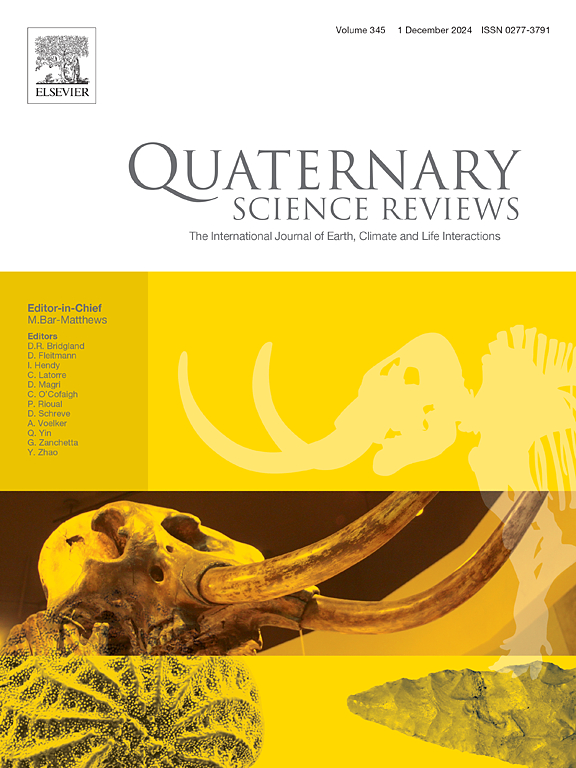Climate and human forcing of montane vegetation dynamics during the past 15,600 years in the Simmental, Northern Swiss Alps
IF 3.3
1区 地球科学
Q1 GEOGRAPHY, PHYSICAL
引用次数: 0
Abstract
To assess future responses of mountain ecosystems to anthropogenic climate warming, a thorough understanding of long-term vegetation responses to past climatic and land-use changes is required. Currently, little is known about former vegetation and land-use dynamics at intermediate elevations in the Swiss Alps, which act as an important ecotone between lowland and subalpine ecosystems. Here, we present a palaeoecological reinvestigation from Chutti (941 m a.s.l.), a small mire located in the montane belt of the Simmental (Simmen valley) in the north-western Swiss Alps. Using pollen, spores, stomata, microscopic charcoal, and X-ray fluorescence (XRF), we reconstructed vegetation, fire, land-use, and environmental dynamics over the past c. 15,600 years. Our pollen record shows four major vegetation transitions: the first transition at c. 14,600 cal yr BP marked the expansion of boreal forests with Juniperus, Betula, and Pinus, the second at c. 11,500 cal yr BP the expansion of temperate continental forests composed of, e.g., Ulmus, Tilia, and Acer, the third at c. 7000 cal yr BP the prevalence of temperate oceanic forests dominated by Abies alba, and the fourth at c. 4800 cal yr BP the massive spread of boreal Picea abies. While the first three vegetational changes were likely controlled by climate, the latter was induced by land use. The strong landscape opening during the Bronze Age (4150-2750 cal yr BP; 2200-800 cal yr BCE) was linked to the existence of a hill-top settlement close to the site. The degree of vegetation openness during the Bronze Age, but also during subsequent epochs, is unique for a site in the Northern Swiss Alps and comparable to more central places on the Swiss Plateau. Based on our results, we argue that if sustainable farming practises are not reinforced, future climate change will result in massive vegetation reorganisations in the Northern Swiss Alps, including the re-expansion of temperate forests.
瑞士阿尔卑斯山北部西门塔尔地区过去15600年气候和人类对山地植被动态的影响
为了评估未来山区生态系统对人为气候变暖的响应,需要深入了解植被对过去气候和土地利用变化的长期响应。瑞士阿尔卑斯是低地与亚高山生态系统之间重要的过渡带,目前对瑞士阿尔卑斯中高海拔地区的前植被和土地利用动态知之甚少。在这里,我们对Chutti (941 m a.s.l)进行了古生态学的重新研究,Chutti是一个位于瑞士阿尔卑斯山西北部西门塔尔(Simmental)山带的小沼泽。利用花粉、孢子、气孔、显微木炭和x射线荧光(XRF),我们重建了过去1.56万年的植被、火灾、土地利用和环境动态。我们的花粉记录显示四个主要植被过渡:第一个过渡c。14600大卡年BP与Juniperus标志着北方森林的扩张,桦木属,松果体,第二年在c。11500大卡BP的扩张大陆温带森林组成的,例如,榆属,椴树属,宏碁,第三年BP在c。7000大卡的患病率由冷杉属温带海洋森林阿尔巴,和c。4800大卡第四年BP北方挪威云杉的大规模传播。前三种植被变化可能是由气候控制的,后一种植被变化是由土地利用引起的。青铜时代(4150-2750 calyr BP)强烈的景观开放;公元前2200-800 calyr)与该遗址附近的山顶定居点有关。青铜器时代的植被开放程度,以及随后的时代,在瑞士阿尔卑斯山北部的遗址中是独一无二的,与瑞士高原的中心地区相当。基于我们的研究结果,我们认为,如果不加强可持续农业实践,未来的气候变化将导致瑞士北部阿尔卑斯山的大规模植被重组,包括温带森林的重新扩张。
本文章由计算机程序翻译,如有差异,请以英文原文为准。
求助全文
约1分钟内获得全文
求助全文
来源期刊

Quaternary Science Reviews
地学-地球科学综合
CiteScore
7.50
自引率
15.00%
发文量
388
审稿时长
3 months
期刊介绍:
Quaternary Science Reviews caters for all aspects of Quaternary science, and includes, for example, geology, geomorphology, geography, archaeology, soil science, palaeobotany, palaeontology, palaeoclimatology and the full range of applicable dating methods. The dividing line between what constitutes the review paper and one which contains new original data is not easy to establish, so QSR also publishes papers with new data especially if these perform a review function. All the Quaternary sciences are changing rapidly and subject to re-evaluation as the pace of discovery quickens; thus the diverse but comprehensive role of Quaternary Science Reviews keeps readers abreast of the wider issues relating to new developments in the field.
 求助内容:
求助内容: 应助结果提醒方式:
应助结果提醒方式:


